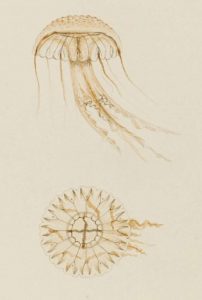Pelagia Noctiluca Jellyfish Illustration

Pelagia (young) Weymouth 1843: Pelagia noctiluca: jellyfish (RAMM Collections)
by Ashley Eyvanaki
Have you seen this jellyfish illustration? This pencil and watercolour sketch was made by Philip Henry Gosse in 1843, and depicts a younger specimen of the pelagia noctiluca jellyfish, which is known for its distinctive lavender colour. As a result, its common name is the ‘mauve stinger’, though it is also known as the ‘purple-striped jelly’, ‘purple people eater’, and ‘night-light jellyfish’. The latter name comes from its Latin title, as pelagia means ‘of the sea’, whilst nocti stands for night and luca stands for light. This refers to the fact that this jellyfish glows in the dark with a lavender luminescence.
Historically, the colour lavender has been linked to LGBTQ+ life and love since the 1920s. There were two movements associated with lavender relating to the queer community – the ‘Lavender Scare’ and the ‘Lavender Menace’. In the United States, the ‘Lavender Scare’ took place alongside the ‘Red Scare’ during the 1950s, paralleling anti-communist ideologies of the Cold War period. This resulted in an internal investigation into homosexual government employees, as they were regarded as communist sympathisers who could be more easily manipulated. As a result, they were viewed as national security risks, resulting in their mass dismissal from federal employment, and normalising homophobic discriminatory policies within federal agencies.
The ‘Lavender Menace’ was a phrase coined by Betty Friedan in 1969, during a speech to the National Organization for Women. During this talk, Friedan stated that they should distance themselves from lesbians, whom she collectively called “the lavender menace”. As such, Rita Mae Brown and other lesbian feminist activists planned a peaceful protest response in 1970, during which they interrupted a women’s event by revealing t-shirts that had ‘Lavender Menace’ emblazoned across them. This turned the tide of public opinion on lesbianism and women’s rights, making it much more positive. As such, at its next national conference the organisation revoked its stance and amended it, stating that lesbian rights were a “legitimate concern of feminism”.
What is your favourite phrase or symbol that has been reclaimed by the LGBTQ+ community? Tell us in the comments below!
